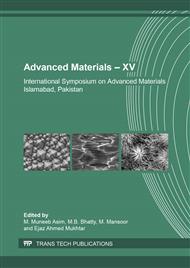[1]
I. Dinca, A. Stefan, A. Stan, Aluminum/glass fiber and aluminum/ carbon fiber hybrid laminates, Incas. Bulle., 2 (2010) 33-39.
Google Scholar
[2]
J.J.C. Remmers, R. de Borst, Delamination buckling of fiber-metal laminates Compo. Sci. Tech., 61 (2001) 2207-2213.
DOI: 10.1016/s0266-3538(01)00114-2
Google Scholar
[3]
T. Sinmazcelik, E. Avcu, M. Ozgur Bora, O. Coban, A review: Fiber metal Laminates, background, bonding types and applied test methods, Mater. Desi., 32 (2011) 3671-3685.
DOI: 10.1016/j.matdes.2011.03.011
Google Scholar
[4]
S. M. Ahmed, C. Anil Kumar, Mechanical Characterization and analysis of perforated fiber metal lamiates, Inter. J. Eng. Tren. Tech., 13 (2014) 216-224.
Google Scholar
[5]
R. A. Silva, Processamento e Caracterização de Compósitos Híbridos Fibra/Metal, PhD Thesis, Instituto Tecnológico de Aeronáutica – ITA/CTA, São José dos Campos, São Paulo, Brazil (2006).
DOI: 10.24849/j.geot.2019..145.03
Google Scholar
[6]
J. Xue, W.-X. Wang, Y. Takao, T. Matsubara, Reduction of thermal residual stress in carbon fiber aluminum laminates using a thermal expansion clamp, Comp. Part A, 42 (2011) 986-992.
DOI: 10.1016/j.compositesa.2011.04.001
Google Scholar
[7]
R. C. Alderliesten, R. Benedictus, Fiber/Metal Composite Technology for Future Primary Aircraft Structures, J. Aircr., 45(2008) 1182-1189.
DOI: 10.2514/1.33946
Google Scholar
[8]
E. C. Botelho, R. A. Silva, L. C. Paradini, M. C. Rezende, A review on the development and the properties of continuous fiber/epoxy/aluminum hybrid composites for aircraft structures, Mater. Res., 9(2006) 247-256.
DOI: 10.1590/s1516-14392006000300002
Google Scholar
[9]
A. Vlot, J.W. Gunnink, editors, Fibre Metal Laminates. Dordrecht: Springer Netherlands; 2001.
Google Scholar
[10]
G. Hector, K. Juan, E. Perez, Short-beam shear fatigue behavior of fiber metal lamintes (Glare)" Intern. J. Fat., 13 (2016) 278-286.
Google Scholar
[11]
E. C. Botelho, L. L. Bourlegat, A. C. Ancelloti Junior, L. C. Pardini, Study of v-notch shear test in carbon fiber epoxy titanium laminates" 19th international congress on Mechanical engineering, Barasilia DF, November 5-9 (2007).
Google Scholar
[12]
G. A. Nitowski, Topographic and surface chemical aspects of the adhesion of structural epoxy resin to phosphorous oxo acid treated aluminum adherends, Doctors of Philosophy in Materials Engineering Science, Blucksburg Virginia, August 26, (1998).
Google Scholar
[13]
N.A. Siddiqui, R.S.C. Woo, J.K. Kim, C.R.Y. Leung, A. Munir, Mode I interlaminar fracture behavior and mechanical properties of CFRPs with nanoclay-filled epoxy matrix, Comp. Part A, 38(2007) 449–60.
DOI: 10.1016/j.compositesa.2006.03.001
Google Scholar
[14]
V. Kostopoulos, P. Tsotra, P. Karapappas, S. Tsantzalis, A. Vavouliotis, T.H. Loutas, et al. Mode I interlaminar fracture of CNF or/and PZT doped CFRPs via acoustic emission monitoring, Comp. Sci. Tech., 67(2007) 822–8.
DOI: 10.1016/j.compscitech.2006.02.038
Google Scholar
[15]
T. Yokozeki, Y. Iwahori, S. Ishiwata, K. Enomoto., Mechanical properties of CFRP laminates manufactured from unidirectional prepregs using CSCNT-dispersed epoxy, Compo. Part A, 38 (2007) 449–60.
DOI: 10.1016/j.compositesa.2007.07.002
Google Scholar
[16]
R.M.H. Jen, Y.C. Tseng, C.H. Wu, Manufacturing and mechanical response of nanocomposite laminates, Compo. Sci Technol., 65 (2005) 775–9.
Google Scholar
[17]
Y. Li, N. Hori, M. Arai, N. Hu, Y. Liu, H. Fukunaga, Improvement of interlamiar Mechanical properties of CFRP laminates using VGCF, Compo. Part A, 40 (2009) 2004-(2012).
DOI: 10.1016/j.compositesa.2009.09.002
Google Scholar
[18]
H. Ning, Y. Li and N. Hu, Improvement of mechanical interlaminar properties of CARALL based on nanofiller interface reinforcement and other fabrication techniques, 13th international conference on fracture, Beijing China, June 16-21, (2013).
Google Scholar
[19]
F. Inam, W.Y. Wong, M. Kuwata, and T. Peijs, Multiscale hybrid micro nano-composites based on carbon nanotubes and carbon fibers, Hindawi Publishing corporation, J. Nanomat., 25 (2010) Article ID 453420, 12 Pages.
DOI: 10.1155/2010/453420
Google Scholar


